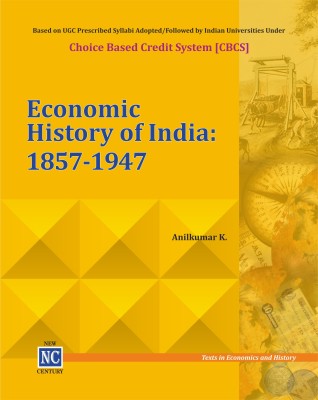Economic History of India: 1857-1947 -(Paperback, by Anilkumar K.)
Quick Overview
Product Price Comparison
The British came to India as merchants in the middle of the 17th century. After gaining foothold on the coastline, they spread to every corner of the Indian peninsula. They gained political supremacy around the middle of the 18th century. After winning the Battle of Plassey in 1757 and the Battle of Buxer in 1764, they established themselves firmly as the rulers of India and ruled it till 1947 to sub-serve their economic interests. The British rule in India can be divided into two periods: (a) the rule of the East India Company from 1757 to 1858 and (b) the rule of the British Government from 1858 to 1947. The British interests in India were governed by the requirements of the Industrial Revolution which started in Britain in the middle of the 18th century and then spread to other regions of Europe. These were two-fold: (a) to secure raw materials from India for factories in Britain and (b) to ensure permanent market in India for the British manufactures. To fulfil these objectives, they adopted measures which proved disastrous for the Indian economy. This book, designed for students pursuing undergraduate and postgraduate courses of Indian Universities and NTA UGC-NET in economics and history, gives a comprehensive and vivid account of various aspects of the Indian economy during the period 1857 to 1947. It is spread over 30 chapters which have been organized into 5 theme parts. Part I (chapters 1 and 2) is titled Colonial India: Background and Introduction. Apart from providing an overview of colonial India, it also explains the state of affairs of the Indian economy on the eve of Independence in 1947. Part II (chapters 3 to 5) is titled Macroeconomic Trends. It deals with discussion on national income estimates, population trends and characteristics, and occupational structure. Part III (chapters 6 to 14) is titled Agriculture, Forests, and Famines. It is devoted to description of agrarian structure and land relations, agricultural markets and institutions, agricultural credit, agricultural commerce, agricultural technology, irrigation development, productivity of agriculture, forest policy and legislations, and famines in India. Part IV (chapters 15 to 22) is titled Railways, Industry, Infrastructure, and Labour. It covers the following topics: Growth of railways, de-industrialization debate, evolution of entrepreneurship, industrial structure, industrialization in the inter-war period, constraints to industrial breakthrough, infrastructure development, and labour laws and industrial relations. Part V (chapters 23 to 30) is titled Economy and the State. It delves into imperial priorities and the Indian economy, drain of Indian wealth, international trade during British rule, capital flows in colonial India, banking and finance, insurance business, tax structure, and evolution of fiscal federalism.


